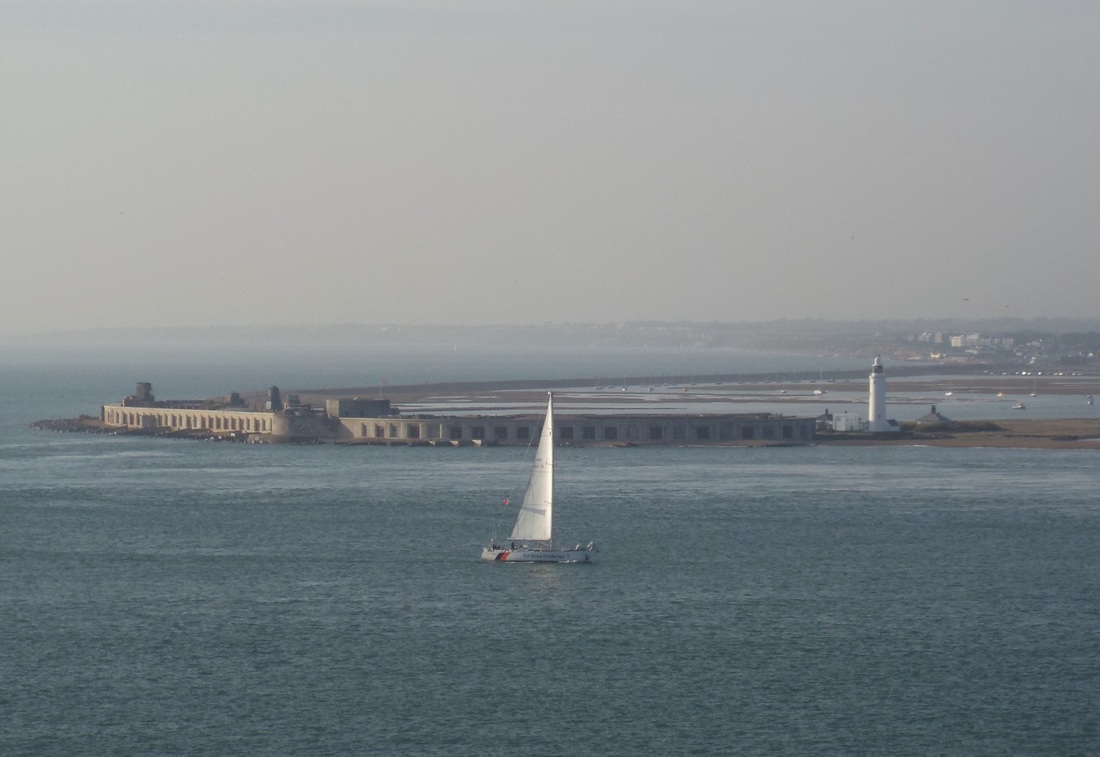The sailing ship in the foreground is Challenger 3 which is operated by the tall ships youth trust.
After spending a few hours at Fort Victoria we walked through woodland and found this view point where I could see the castle across the Needles Passage.
Hurst Castle was built between 1541 and 1544 by Henry VIII as part of a chain of artillery fortresses protecting key ports and landing places around southern England. The castle guarded the Needles Passage leading to the Solent, the port of Southampton and the growing naval base at Portsmouth. It was extensively modernised in the 19th century and remained in military use until 1956.
The long shingle spit on which the castle was built leaves a channel between the Isle of Wight and the mainland only 1280m wide at this point. In 1539 fear of invasion from the united Catholic powers of Europe led the king to mastermind a series of defensive measures, although by 1540 the fear of invasion had generally subsided building work began on Hurst Castle in 1541. After it was completed in 1544 the castle was armed with about 20 guns of varying calibres.
During the Civil War (1642–51) the castle was held for Parliament. It was never attacked but Charles I was imprisoned in the keep from 1 to 19 December 1648 after the Parliamentary army ordered his arrest and transfer from Carisbrooke Castle on the Isle of Wight. On 19 December 1648 he was taken from Hurst Castle on the journey leading to his execution in London six weeks later.
In 1700 Hurst was again selected as a secure prison, this time to hold anyone convicted for spreading the Roman Catholic faith. Only one prisoner was sent here, Father Paul Atkinson. Despite several pleas for clemency he remained in the castle for 30 years until his death at the age of 74.
The outbreak of war with Revolutionary France in 1793 saw a rapid strengthening of Britain’s coastal fortresses and after hasty repairs to Hurst in 1794 18 captured French 9-pounder weapons were installed and two five-gun batteries equipped with French 36 Pounders were also built on the beach on either side of the Tudor fortress.
In 1803 the threat of invasion by Napoleon led to additional work on the coastal defences. At Hurst the centre of the Tudor castle was transformed with the installation of six powerful 24-pounder guns on the roof and a basement gunpowder store. The Tudor bastions were also improved so that they could safely support 8 Pounder French guns.
In February 1809 all spare space here was turned into a temporary military hospital for survivors of Sir John Moore’s army. After their 250-mile fighting retreat through northern Spain to the port of Corunna these sick and wounded men were rescued by the Royal Navy and brought safely back to Hurst
The moat was deepened in 1851 and its immediate defences strengthened. Between 1852 and 1854 the bastions and curtain walls were extensively modified so that a second tier of guns could be mounted. Outside the castle two large earthwork batteries were built for 29 heavy weapons.
These works were hardly finished before technological revolutions in weapon systems and the introduction of steam-powered warships made such fortifications obsolete. In 1859 a Royal Commission was created to consider the defence of the United Kingdom, as part of this programme work to strengthen Hurst Castle began in 1861. The earthwork batteries were replaced by huge armoured wing batteries. Largely completed by 1874 these housed 31 new guns which fired shells weighing more than 360kg, Accommodation was also provided for a garrison of 143 officers and men.
In 1893 a battery for three of the new 6-pounder QF guns was built outside the end of the East wing. A little later three 12-pounder QF guns were added to the keep and the West wing together with searchlights.
Variants of these weapons together with AA Guns provided the castle’s armament during World War 2 where again the castle played a key role in protecting the western entrance to the Solent. In 1956 Hurst Castle came into the care of the Ministry of Works, predecessor of English Heritage.
The lighthouse to the left of the picture has ben operational since 1867.

 RSS Feed
RSS Feed
